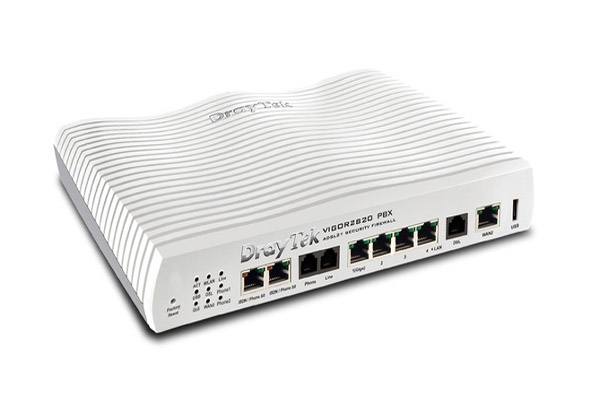Draytek VigorIPPBX 2820 review
We review the Draytek VigorIPPBX 2820 to see if its combined router and IP PBX capabilities make life easier than buying two separate products.

This device's IP PBX feature set is ideal for a small office. Although it's not as powerful or flexible as advanced dedicated IP PBX systems, it's incredibly simple to set up and did everything we asked of it. Call quality was excellent and we had no problem using it with our usual VoIP phones and softphones. The Vigor's capabilities as a router are as simple and effective as its IP PBX features. There's remarkably little on market to compare it to, as this is the first device we've seen from a major manufacturer to combine a router with an IP PBX. At around £370, it costs a little over twice as much as Draytek's standard Vigor 2820 router. Although it may be possible to buy a similarly specified dedicated IP PBX appliance and a separate router for a little less, configuration will certainly not be as simple as it has proved to be with the VigorIPPBX.

In addition to the usual URL, keyword and category based website blocking, the router's firewall allows you to block P2P and internet messaging for specific clients and protocols. This is helpful if, for example, you wish to block P2P file sharing via Kazaa but require BitTorrent traffic to still go through. Instant messaging blocking is even more refined, allowing you to not only block specific clients or protocols, but also to allow some features of a client (such as messaging and voice communication under MSN) while blocking others, such as video messaging or games. Several web-based messaging services can also be blocked, as can Skype or SIP VoIP traffic. The firewall settings also allow you to enable protection against a wide range of Denial of Service attacks.
In the menu below, the IP Objects settings enable you to group together different ranges of internal or external IP addresses, protocols, services, or even file types to make it easier to apply firewall rules. In the following Bandwidth Management menus, the Bandwidth Limiting settings are handy if you want to limit the amount of bandwidth made available to certain IP ranges, either permanently or on a set time schedule.
You can also limit the number of sessions permitted to a specified IP range. Time scheduling can be applied to these settings. Quality of Service (QoS) options can be set, but these require fairly in-depth configuration, as there aren't any pre-set categories to make it easier to prioritise different types of traffic.
Get the ITPro daily newsletter
Sign up today and you will receive a free copy of our Future Focus 2025 report - the leading guidance on AI, cybersecurity and other IT challenges as per 700+ senior executives
K.G. is a journalist, technical writer, developer and software preservationist. Alongside the accumulated experience of over 20 years spent working with Linux and other free/libre/open source software, their areas of special interest include IT security, anti-malware and antivirus, VPNs, identity and password management, SaaS infrastructure and its alternatives.
You can get in touch with K.G. via email at reviews@kgorphanides.com.
-
 Westcon-Comstor and Vectra AI launch brace of new channel initiatives
Westcon-Comstor and Vectra AI launch brace of new channel initiativesNews Westcon-Comstor and Vectra AI have announced the launch of two new channel growth initiatives focused on the managed security service provider (MSSP) space and AWS Marketplace.
By Daniel Todd Published
-
 Third time lucky? Microsoft finally begins roll-out of controversial Recall feature
Third time lucky? Microsoft finally begins roll-out of controversial Recall featureNews The Windows Recall feature has been plagued by setbacks and backlash from security professionals
By Emma Woollacott Published
-
 The UK government wants quantum technology out of the lab and in the hands of enterprises
The UK government wants quantum technology out of the lab and in the hands of enterprisesNews The UK government has unveiled plans to invest £121 million in quantum computing projects in an effort to drive real-world applications and adoption rates.
By Emma Woollacott Published